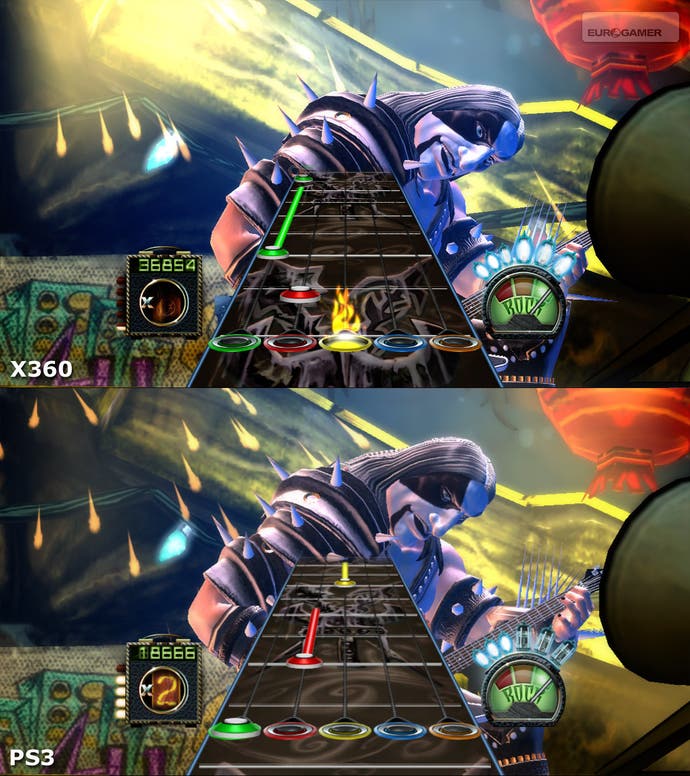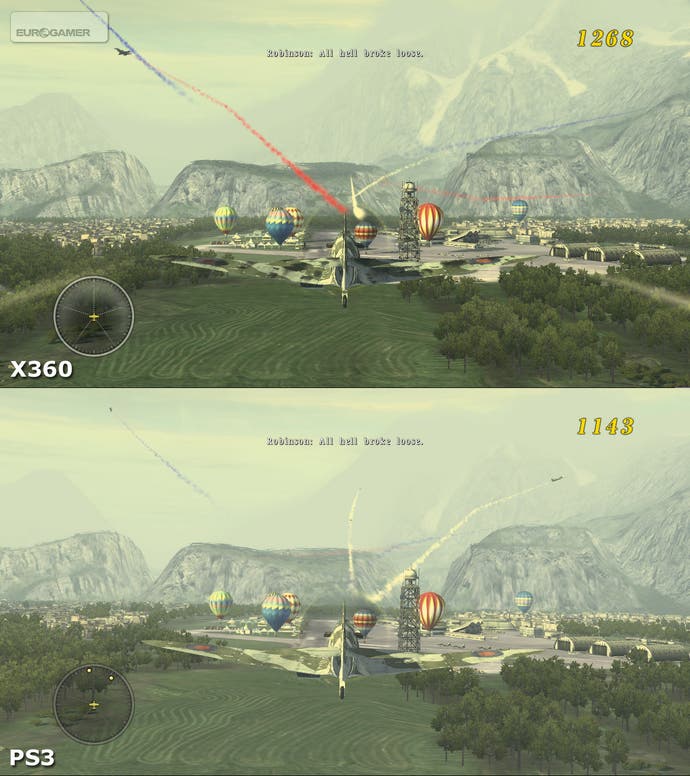X360 vs. PS3 Face-Off: Round Seven
One man, 12 games, many arguments.
Tony Hawk's Proving Ground
I don't think it's too controversial to suggest that Tony Hawk's Proving Ground is a somewhat disappointing release in the wake of EA's excellent Skate. However, what did surprise me in testing out this game was just how much I missed the accessibility of Neversoft's control system, the satisfying ease with which combos can be strung together, and the basic fact that your skater actually does what you want him to do without the need for the absolute precision demanded by EA's offering. It's clear that Hawk still has a certain something in its arsenal that the creators of Skate have yet to surpass; it's a just a shame that the look and feel of Proving Ground no longer matches the series' gloriously over-the-top arcade roots. Somehow the grimy US inner city environments seem somewhat at odds with a game that has always been bright, vibrant and attractive.
While this game just doesn't have the basic appeal of its Project 8 predecessor, efforts have been made to tighten up the experience technically. Whereas both Xbox 360 and (especially) PlayStation 3 versions of the last game suffered from wildly variable frame-rates, Proving Ground feels a lot more stable on both platforms. What is curious though is whereas P8 ran at a sub-HD resolution on 360 and at full 720p on PS3, with the new title the situation has been reversed. The PS3 version has been hacked down to 1067x600 vs proper 720p on 360 - with rough software scaling attempting to bring the image back up to proper HD resolution. Both versions are pegged at 30fps which guarantees the stability, though I have to admit that I did miss the smoother update of Project 8 (which at times hit 60fps on 360).
The reduction in resolution serves to make the PS3 game far jaggier and less detailed than it does on Xbox 360, the lighting doesn't look so good, and a great many of the special effects employed (especially in the game engine-powered cut-scenes) have been diminished or removed altogether. What is already a pretty unattractive game in its base Xbox 360 incarnation therefore looks even less appealing on the PlayStation 3.
Gameplay-wise though, there's nothing to distinguish either version from the other - as you would expect the actual experience in playing Tony Hawk's Proving Ground is essentially uniform on both platforms. And in this respect, John Walker's comments in the original review still apply whichever console you might happen to own. Despite dodgy implementations of many of the new features, Neversoft's core gameplay still feels good, and there's a vast range of challenge spread across the three main cities in the game. But whereas Project 8 and Skate are still the better buy for Xbox 360 owners, PS3 players might prefer to check out Proving Ground. While still technically limited, at least this time the compromises don't adversely affect the way the game plays - an issue for both P8 and Skate on the Sony console.
Guitar Hero III: Legends Of Rock
A stonking great nine out of ten review score for this latest instalment in the phenomenally popular rhythm-action series, and an intriguing game for a couple of reasons. First of all, it's the first outing for the franchise on PlayStation 3, and secondly, original coders Harmonix had little to do with it, having handed over their instruments to Tony Hawk coders Neversoft, who - and let's be honest - have a somewhat patchy track record when it comes to PS3 development.

Guitar Hero III does little to improve that reputation. Whereas the Xbox 360 version runs at full 720p, the PS3 conversion falls some way short - running at something like 1040x585. The worst of it is eclipsed by the range of cool lighting and pyrotechnic effects employed to create the party atmosphere as well as the 60fps update, but let's be clear here - Guitar Hero III isn't exactly the most taxing of games graphically so why there is any compromise at all raises some questions over Neversoft's ability to work with the Sony architecture, especially in the light of deficiencies in both of their PS3 Tony Hawk offerings.
The PlayStation 3 rendition of the game also comes with one or two other unwelcome pieces of baggage; first of all there's the lack of downloadable content compared to the 360 version, and secondly the inability to use your GH guitars with EA's excellent Rock Band - a game I'm sure all GH fans will want to check out; both factors worth bearing in mind if you're lucky enough to own both consoles and you're choosing which version to buy.
Thankfully though in terms of the raw gameplay and overall impact, there's nothing of staggering consequence to tell these games apart; the 360 version is simply the more attractive version. Guitar Hero III remains as excellent as ever on either platform when it comes to the sheer experience of playing it. However, I'm sure I'm not the only one to take umbrage with the original review's dismissal of the uneven difficulty level - the lower settings being too easy, the higher levels stupidly, preposterously tough.
Blazing Angels: Secret Missions Of WWII
The original Blazing Angels is an Xbox 360 title I have to admit I liked, even though the game tries so hard to make a contrary impression. Dragged down by some horrific difficulty spikes and eye-wateringly bad screen-tear, I still managed to enjoy its basic dogfighting action and its occasional flashes of graphical brilliance. But more than that, I enjoyed the fact that a major publisher was willing to take a risk by putting out a game like this; gameplay literally from another age but with some semblance of 'next gen' graphical credentials.

On paper at least this sequel should be a far superior proposition than its misfiring predecessor featuring a number of core improvements. Online dogfighting has been boosted along with the welcome ability to meaningfully upgrade your craft. From a narrative perspective, the teeth-grindingly awful characterisation and voiceover has also been improved somewhat too. All good things of course, but unfortunately the 'engine' that powers the game hasn't been upgraded a jot, meaning that the brain-melting screen-tear that places the two v-lock torn halves of the screen in different time zones remains as unbearable as ever.
But the core issue with this game is that the real problems inherent in the original game have not been addressed at all. Blazing Angels II's lack of tangible improvement over the original in terms of the basic gameplay has the desperate smell of a rushed cash-in sequel about it, and as such it's rather lost its original 'risk-taking' charm. It's also a game that is equally 'meh' on either console format. There's a range of minor graphical differences in terms of effects, lighting and draw distance, with neither version really having the better of the other from one level to the next.
Table of contents
- Kane and Lynch: Dead Men
- TimeShift
- Ghost Recon Advanced Warfighter 2
- Tony Hawk's Proving Ground
- Guitar Hero III: Legends of Rock
- Blazing Angels: Secret Missions of WWII
- Medal of Honor: Airborne
- Dynasty Warriors: Gundam
- Bladestorm: The Hundred Years' War
- Lego Star Wars: The Complete Saga
- Clive Barker's Jericho
- John Woo Presents Stranglehold







